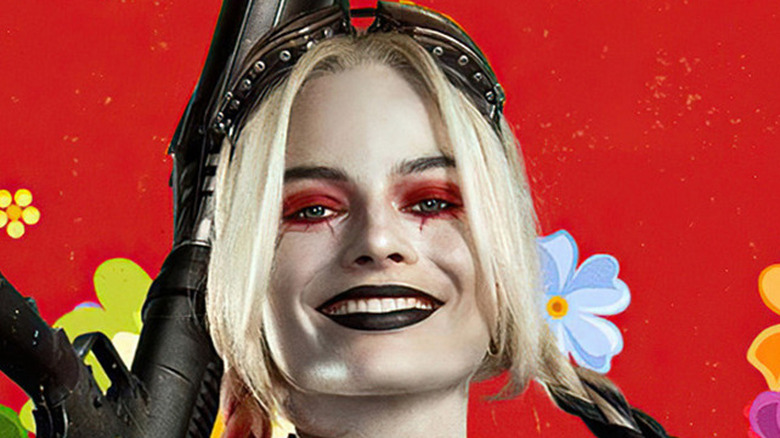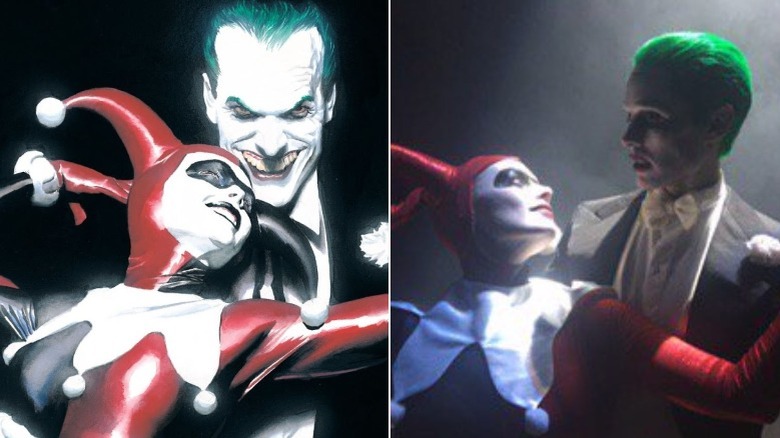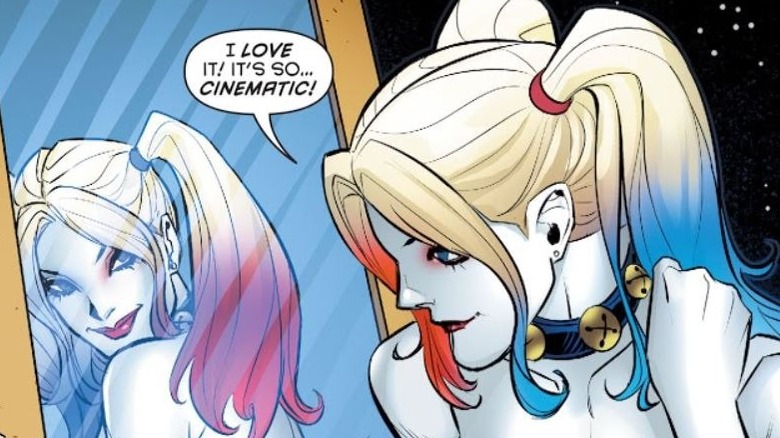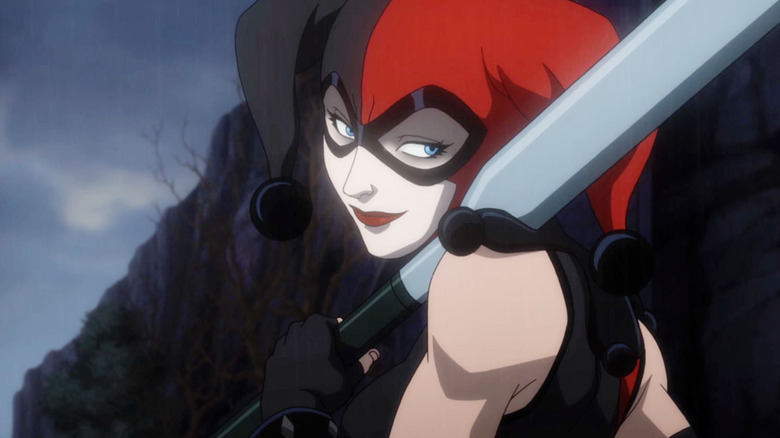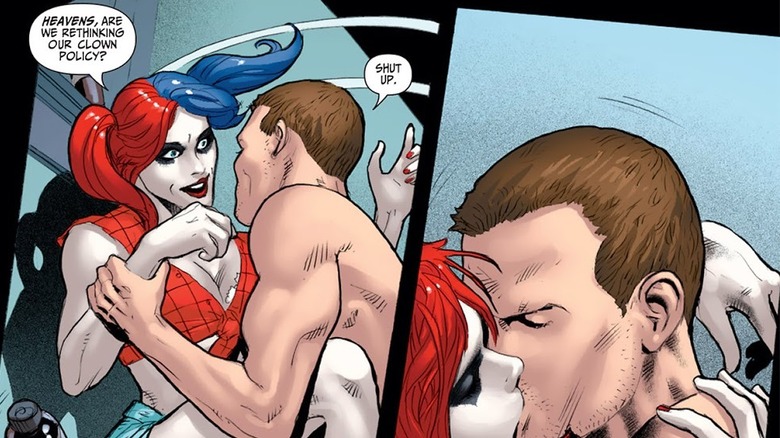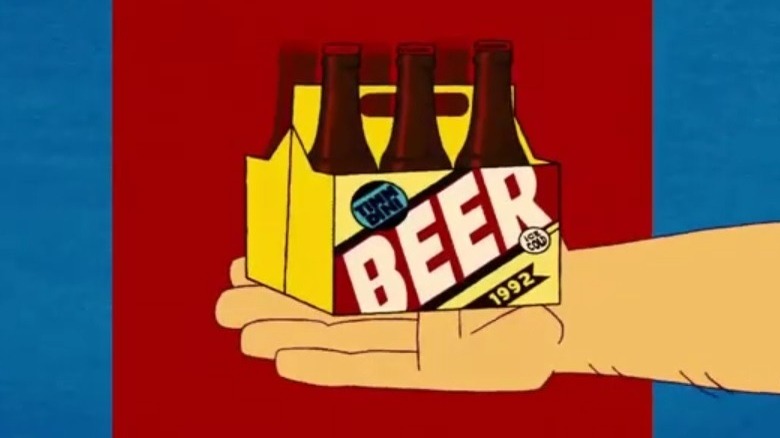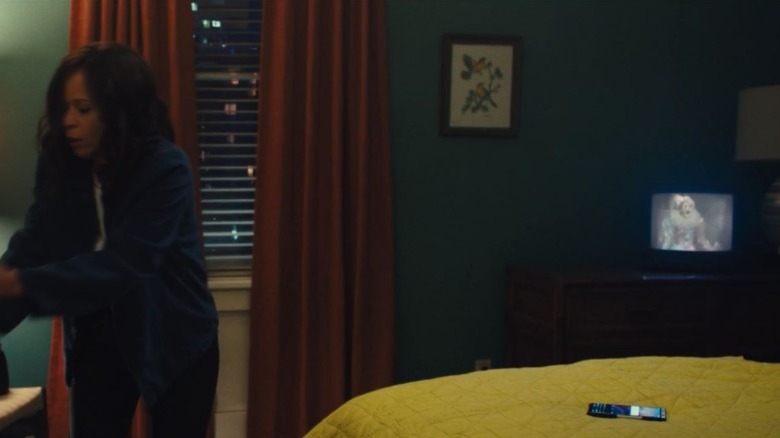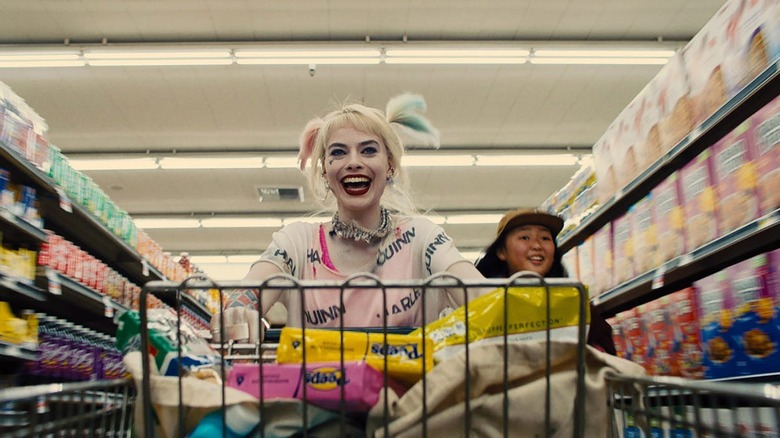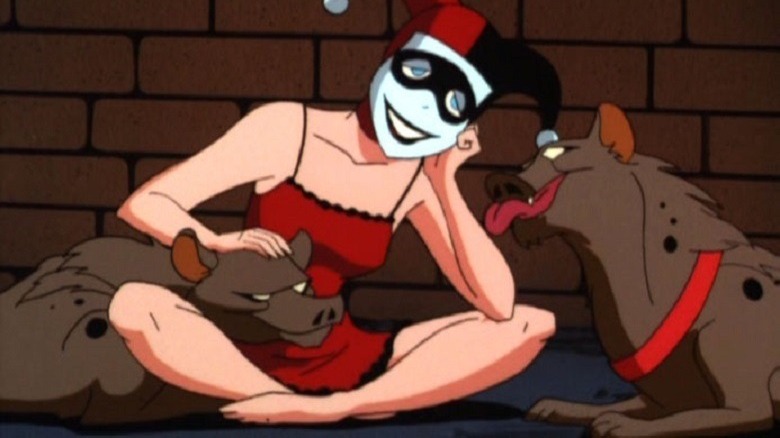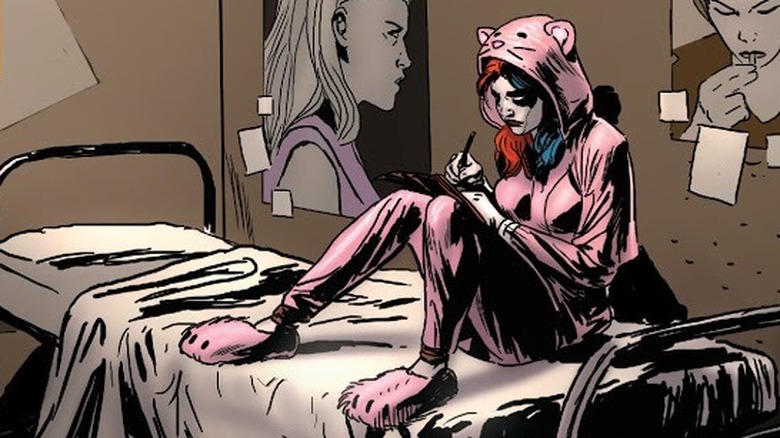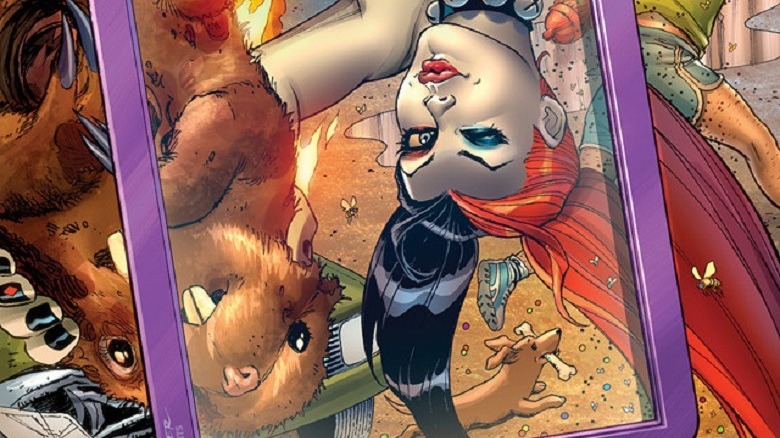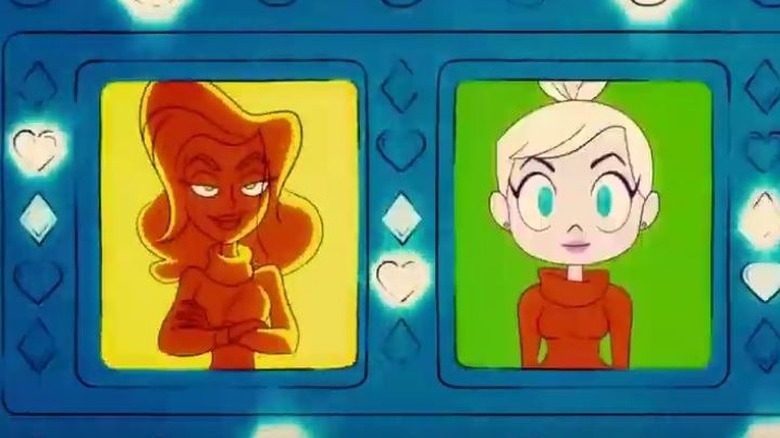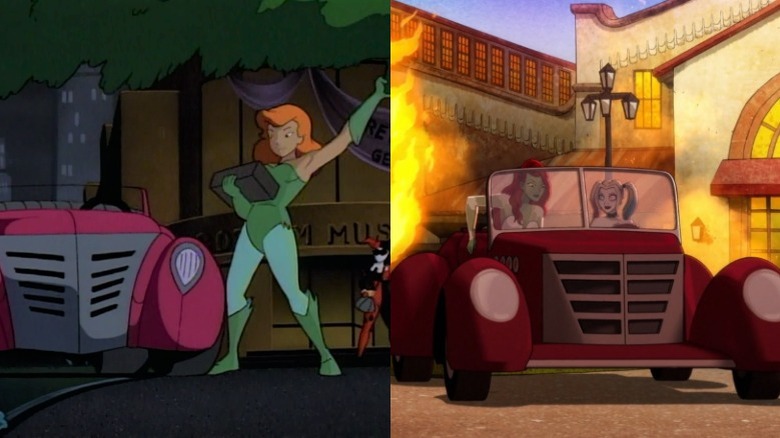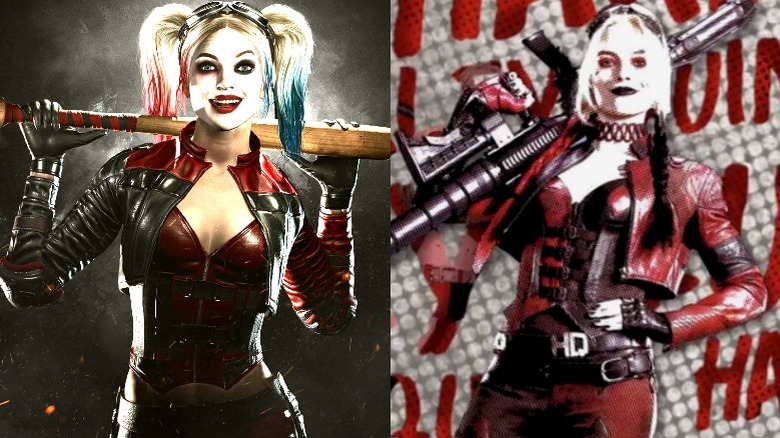The Best Harley Quinn Easter Eggs Of All Time
Since her 1992 debut on "Batman: The Animated Series," Harley Quinn has become one of DC Comics' most popular characters. With her happy-go-lucky demeanor and freedom from society's constraints, it's easy to see why the Clown Princess of Crime is so beloved. Not only is she fun, Harley's many quirks and flaws make her enormously relatable, especially when compared to other comic book characters. Superman and Wonder Woman are massively powerful and utterly good-hearted, which mere mortals fall far short of. Harley, in contrast, is a survivor just trying to enjoy the ride. This is the essence of the human struggle — no wonder she resonates.
Despite her comparatively short existence, Harley has been featured in numerous comic books, video games, and animated productions. This makes her ripe for Easter eggs, especially with the recent addition of live-action films to Harley's resume: David Ayer's "Suicide Squad" and Cathy Yan's "Birds of Prey" are positively loaded with various Harley-centric references, many of them obscure enough to please even the most die-hard fan. From nods to landmark moments in harlequin history to homages to Harley's true love (spoiler alert — it's not Joker!), these are the most epic Harley Quinn Easter eggs to date.
Dancing with history
2016's "Suicide Squad" is loaded with clever Easter eggs hidden throughout the film's sets and character designs, especially in regards to the Joker and Harley Quinn. One reference that makes comic book fans cheer can be spotted during Amanda Waller's exposition at the beginning of the film. While outlining the shady pasts of each Suicide Squad member to her equally shady colleagues, Waller explores the origins of the Joker and Harley's relationship in a dazzling montage.
Part of this quick trip down memory lane shows the Clown Prince of Crime dressed in a tuxedo, dancing with Harley in her classic black and red jester attire. This pas de deux is an homage to an iconic portrait of the pair painted by superstar artist Alex Ross, which graced the cover of a ground-breaking 1999 one-shot, "Batman: Harley Quinn." This issue formally introduced Harley to DC Comics canon, and greatly expands upon the few breadcrumbs of information dropped about her in "Batman: The Animated Series."
Up until this point, Harley had been a simple side-piece for the Joker. This issue solidifies her as a fleshed-out, three-dimensional character. Ayer cemented the reference's importance when he posted a still from the "Suicide Squad" scene to his Twitter, showing Jared Leto and Margot Robbie holding the exact pose seen in Ross' beloved illustration.
New hair, do care
One "Suicide Squad" reference that's gone mostly unnoticed by fans sits right on top of Harley's pretty little head. Her bleached-blonde, two-tone hair actually originates in the pages of DC Comics, and symbolizes a powerful moment of liberation from her abusive relationship with the Joker.
In 2011, DC revamped their entire line of comics with a massive brand relaunch called the New 52. The event overhauled Harley's origins, as it did many other characters: According to the New 52, after Harley fell in love with the Joker and broke him out of Arkham Asylum, he sealed her initiation into evil by throwing her into the same vat of acid he accidentally fell into in "Batman: The Killing Joke." This chemical bath not only twisted Dr. Harleen Quinzel into Harley Quinn, it left her skin permanently bleached like the Joker's, and dyed her natural blonde locks half red, half black.
After continuing their on-again, off-again relationship for a while, Harley breaks up with Joker once and for all in epic fashion in 2016's "Harley Quinn" #25 by locking herself in his cell with him and duking it out until she's the last one standing. In the following issue, Harley's friend Queenie helps her commemorate this moment by bleaching her hair into the blonde two-tone ombre look later rocked by Margot Robbie. There's even a hint in the comic book of the character's impending debut in a live-action film, with Harley remarking, "It's so cinematic!"
The other Suicide Squad movie
Among other influences, Harley Quinn's look in Ayer's "Suicide Squad" also has roots in DC's animated movies — specifically, 2014's "Assault on Arkham." This action-packed thrill ride takes place in the world of the "Batman: Arkham" video games, and happens between the events of "Arkham Origins" and "Arkham Asylum." The storyline follows the Suicide Squad as they infiltrate Arkham Asylum on behalf of their shadowy leader, Amanda Waller.
One can't help but see similarities between "Assault on Arkham" and "Suicide Squad." Both films feature a connection between Deadshot and Harley, although the one in the animated film is far spicier. Both include Squad members like Captain Boomerang. And perhaps most noticeably, both takes on Harley incorporate certain aesthetic details.
At first glance, the two-tone leggings, military boots, and classic jester hat she sports in "Arkham" seems to contrast starkly with the revealing outfit donned by Margot Robbie. However, a more nuanced eye will note resemblances between the finer details. Both Harleys wear studded belts, complete with oversized diamond buckles, and single gloves worn on the left hand, topped with spiked bracelets. Both Harleys carry a trusty baseball bat. Both Harleys even sport the same jester-style Joker tattoo on their backs!
A nod to classic animation
Harley Quinn loves to walk softly and carry a big stick. Fans have come to know her specific preference for mallets, which have become as much a part of the character as her iconic pigtails and two-tone color scheme. Harley has also been known to swing a baseball bat around, as seen in "Assault on Arkham" and in the hands of every "Suicide Squad" cosplayer since 2016. While obsessing over every detail of Harley's "Suicide Squad" bat, fans discovered many Easter eggs hidden in the words scrawled across the wooden wonder. One of the more obscure and awesome references written in Harley's loopy script is a quote from "Batman: The Animated Series."
In the episode "Joker's Favor," the Joker, Harley, and their crew manage to crash a black-tie affair honoring Police Commissioner Jim Gordon at the Gotham Peregrinators Club. The villains announce their malicious intent, with Harley blowing a whistle and exclaiming, "Here's to Gotham's Commissioner G. You lock up the weirdos, the crooks, and the geeks. You're a hero to all the boys in blue, but this time, baby, the joke's on you!" The last two sentences of this chilling yet quirky announcement are written on Harley's bat, right under the "T" in "Good Night" — except "baby" has been changed to "Puddin."
More than just the Joker's girl
Since the release of "Suicide Squad" in 2016, director David Ayer has been incredibly candid about the many differences between his original vision and the final cut approved by Warner Bros. Making films is a complex process involving input from many minds. This often results in compromises which leave some creative parties unhappy. Ayer has been very interactive with the general public on social media, graciously taking the time to answer questions and break down fan theories. A few of those online Q&A sessions have revealed Ayer's initial intent to include a romance between Harley Quinn and Deadshot.
This affair isn't just an interesting idea left on the cutting room floor — it has basis in DC canon. Although she's devoted to Joker to an unhealthy level, Harley shares a passionate physical connection with Deadshot in the "Suicide Squad" series that began in 2011 — complete with a poorly-timed reference to one of her body parts being like a "clown car." Ahem.
Knocking back some ice cold Timm Dinis
Cathy Yan's 2020 film "Birds of Prey" is ripe with references. One fun Easter egg is hidden in the animated intro, when Harley is discussing how her not-so-fun childhood was shaped by her father's grim determination to "get rid" of her. She claims he even committed the despicable act of trading his daughter for a six-pack of beer, only for her to return, undaunted. This most definitely explains a thing or two about some of Harley's issues.
Yet even this tragic detail contains a bit of a humor — and a seriously clever Easter egg. Ever since Harley made her debut in "Batman: The Animated Series," she has broken boundaries and lined pocket books. An homage to the giants who created her, and that storied series, is hidden on the label of the six-pack Harley's dad tries trading her for: Apparently, he likes to sip ice-cold "Timm Dini" brewskis from 1992. 1992 is, of course, the year Harley Quinn and "Batman: The Animated Series" first hit the airwaves, while Bruce Timm and Paul Dini are Harley's creators, and, alongside Mitch Brian, the masterminds of the series. Harley also rocks the number 92 on her roller derby jersey in "Birds of Prey," another nod to her inaugural year.
Harley's soap opera origins
Inspiration comes in many forms. For example, Paul Dini found his muse for Harley Quinn in "Days of Our Lives." In the 1980s, Dini's college friend, actress Arleen Sorkin, was cast on the show as a quirky blonde with a thick New York accent named Calliope Jones. One episode contains a fairy tale dream sequence, in which Calliope plays a roller-skating harlequin wearing a sparkly blue and pink jester costume. When Dini watched it, he'd been toying with the idea of a female henchman for the Joker. Sorkin cartwheeling around in clown makeup proved to be the inspiration he needed to make that nascent idea into a fully-formed character.
Sorkin was later cast as Harley Quinn on "Batman: The Animated Series," establishing the status quo for the character's iconic New York accent. She continued to portray Harley in other cartoons and video games until 2012. A nod to her can be glimpsed in "Birds of Prey," on a tiny TV set in Renee Montoya's apartment: While she's preparing for the final showdown at Amusement Mile, the "Days of Our Lives" episode featuring Sorkin's jester sequence can be seen playing.
An epic sweet tooth
If you've ever wondered how Harley Quinn maintains the intense energy required for her busy life as a crazed, gymnastics-savvy, mallet-toting clown queenpin, wonder no more. She has one simple secret: Make cheat day every day, all day.
Harley's love of junk food and sweets has been evident since audiences first saw her sipping grape soda in the "Mad Love" episode of "Batman: The Animated Series." Ayer's "Suicide Squad" references this when Joker romantically tells Harley he has "grape soda on ice" waiting for them, during the helicopter rescue scene. In addition to soft drinks, Harley also loves candy, especially Peeps, as seen in "Birds of Prey", and, of course, cotton candy, as befits her circus clown image.
Harley also loves milkshakes, hot dogs, hamburgers, and salty French fries, especially from a chain heavily featured in her post-New 52 solo series called "Nate-man's Famous." This is an homage to Nathan's Famous Hot Dogs, a real-life chain originating in Harley's home neighborhood of Coney Island, New York.
Harley's wild menagerie
As audiences learn while watching "Birds of Prey," Harley Quinn lives her life in extremes, even when it comes to her choice of pets. Adopting a hyena doesn't seem like the wisest choice for a gal to make, let alone two. But Harley does, in fact, possess two pet hyenas in her very first incarnation.
Originally seen in "Batman: The Animated Series," Harley's pair of pet hyenas are named Bud and Lou. They've been featured in numerous comic books and video games since — they memorably serve as one of Harley's special abilities in the "Injustice" series of video games. One might ask why Harley would want to own such fearsome beasts, other than to instill terror in enemies. It's simple: Spotted hyenas' vocalizations sound like laughter to human ears!
Harley has a particular fondness for Bud and Lou, feeding them steak dinners and referring to them as her "babies." Though this duo is replaced in the DCEU by a single hyena named Bruce (named "for that hunky Wayne guy"), Harley does share her Twizzlers with her beloved pet.
Cuddling up in a pink cat onesie
One Easter egg in "Birds of Prey" points to a darker aspect of Harley's past. While Harley is mourning her break-up with Joker, she is shown wearing a pink cat onesie and binging on ice cream. She has donned the same cozy-cute onesie before, while struggling with another moment of vulnerability in 2013's "Suicide Squad" #20. This series of comics features some of the darkest panels in DC history, crammed with torture and violence. Few "Suicide Squad" characters get through the run unscathed – especially poor Harley.
Here's a brief recap of the dense plot leading up to #20: Harley is severely traumatized by experiences on the Suicide Squad under Amanda Waller. She breaks up with the Joker and starts a rebound relationship with Deadshot, only for him to die on a mission. She's told the Joker is dead, then gets punched in the face by him while mourning Deadshot at his funeral. She is then forced by the Joker to kill Bud and Lou, in order to save her own life. You'd snuggle up in a pink cat onesie too after going through all that.
Bernie the Beaver
One of the odder sights in "Birds of Prey" is a taxidermy beaver in a pink tutu, first glimpsed next to Harley as she cries into her ice cream. His name is Bernie, and yes, ladies and gentlemen, he is canon: Bernie made his debut in 2014's "Harley Quinn" #0. In high school, Harley dated a boy named Bernie Bash, who shared her affinity for morbid humor and, well, plain old morbidity. But their budding love was cut short after Bash went to juvenile detention for throwing one of Harley's enemies into the path of an oncoming truck. As a way to remember his twisted devotion, Harley snuck into his house and grabbed Bernie. Hey, when your family is into hunting and taxidermy, you're bound to have stuffed, dead animals lying around.
Bernie and Harley share full conversations, with Bernie usually being the voice of reason — but, of course, only Harley can hear his responses. You know what they say about voices other people can't hear ... they have all the best jokes! The fact Bernie is in "Birds," and that the film leaves him unexplained, nameless, and silent, makes his presence a truly delightful inside joke comic readers get to share with Harley.
Harley's mysterious redheaded ex
Some fans idealize Joker and Harley, but those intimately familiar with the ups and downs of Harley's love life know there's a far healthier option to root for: Poison Ivy and Harley Quinn. Ever since the duo first met on "Batman: The Animated Series," Poison Ivy has made Harley stronger and more resilient, literally and figuratively — she's often depicted as having dosed Harley with a concoction that immunizes her against toxins!
Ivy and Harley's bond has grown massively in the years since they first enjoyed violent girls'-nights-out on "Batman: The Animated Series." Little by little, romance has crept into their friendship, cheered on by a passionate fanbase. Eventually, "Harlivy" became canon on multiple fronts: 2016's "DC Comics: Bombshells" #42 features their first kiss (albeit in an alternate universe), while 2017's "Harley Quinn" #25 sees them smooch in the mainstream DC continuity. The second season of 2019's "Harley Quinn" animated series is, in fact, largely built around Harley and Ivy working up the courage to admit they love each other.
Unfortunately, this relationship hasn't yet had its time on the big screen, despite the best efforts of one Margot Robbie. But it is hinted at in "Birds of Prey:" During the animated intro, Harley highlights a few of her former lovers, one of which is a vivacious woman who strongly resembles Harley's chlorophyll-powered bae.
Ride or die
Harley and Ivy's relationship takes center stage in the excellent 2019 animated series "Harley Quinn." The show is loaded with Easter eggs and obscure references, one of the best being stuffed into the second season's final episode. Harley and Ivy, pursued by Gotham's finest, are riding off into the sunset together in a pink convertible resembling an early '40s Cadillac. This fairy tale ending mimics the way their relationship began nearly 30 years prior on "Batman: The Animated Series:" In "Harley and Ivy," Harley gets kicked out by the Joker and decides to steal a prized diamond. She is interrupted mid-robbery when the alarm gets tripped by someone else. While running for cover, Harley crosses paths with Poison Ivy, also attempting a heist.
It looks as though the two will be caught by the police — until Ivy unveils a pink convertible with a novelty license plate reading "ROSEBUD," hidden under some brush. The two ladies hop in and drive off into what Ivy describes as "the beginning of a beautiful friendship." This car has the same distinctive bodylines and headlights as the car in "Harley Quinn." What an eloquent way to bring things full circle, and what better car for the two to finally admit they love each other in?
Pigtails, jackets, and leather
James Gunn's "The Suicide Squad" is so packed with Easter eggs, even its trailers offer multiple reference-spotting opportunities. Harley Quinn's new duds catch the eye immediately: Seeing her twirl about in a pretty, flowing red dress while spreading mayhem just feels right. Some women were simply born to cause carnage in couture.
Harley's primary outfit, however, is a bit more practical, consisting of red and black pants, a leather jacket, braided hair, and big, stompy military boots. This costume is one made for kicking butt in, and is far more faithful to Harley's roots in comic books and video games than her 2016 "Suicide Squad" look. In fact, this outfit is almost a mirror image of her default look in 2017's "Injustice 2," a popular DC Comics-based fighting game. Likewise, her long blonde pigtails are a throwback to her looks in other video games, most obviously 2011's "Batman: Arkham City" and 2015's "Batman: Arkham Knight."
